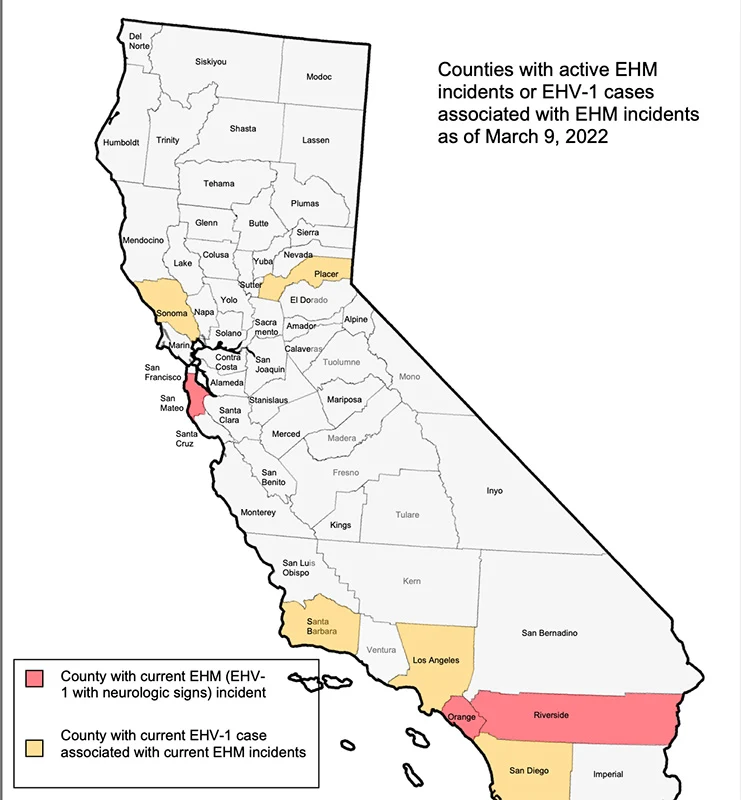A Los Angeles barn where a horse that had contracted equine herpesvirus myeloencephalopathy (EHM) was euthanized Feb. 22 has been released from quarantine by the California Department of Food and Agriculture, with no other cases reported at the facility. Ventura County also no longer has active EHV-1 cases after a horse that had been quarantined since testing positive for EHV-1 after returning from Desert International Horse Park also was released from quarantine March 9, reducing the number of California counties with active cases to eight.
In an outbreak that has claimed the lives of several horses and sickened more than 60 others, the case of the 20-year-old warmblood gelding in Los Angeles County had garnered particular public attention for several reasons.
The horse had attended the LA February show, held Feb. 18-20, and reportedly never had a fever but developed neurological symptoms Feb. 22, after returning to its home barn, that quickly became so severe that it had to be euthanized. It was not until several days later that test results were returned confirming it had EHM.
Word of the horse’s death came against the backdrop of other news from the LA February show, namely that several trainers and four horses had attended it within fewer than seven days of leaving DIHP in Thermal, California, where EHV-1 first had been confirmed Feb. 11. At that point in the outbreak, officials were recommending at least seven days of quarantine and temperature monitoring for any horses that had competed recently at DIHP (protocols have been beefed up significantly since), and managers of the LA show said that when they learned of horses that had traveled between the two shows within that seven-day window, those trainers were immediately told to remove them from the show grounds.

California counties with current active EHV-1 and EHM cases. Courtesy Of California Department Of Food And Agriculture
Since then, barns that had horses at that show but not DIHP have had horses test positive for EHM and EHV-1. However, while CDFA investigated possible links between cases at the show grounds in Los Angeles and Riverside counties, they did not find a definitive one.
“[W]ith epidemiology, it can be difficult to definitively prove one way or another that cases are linked,” CDFA representative Dr. Katie Hatch said in an email. “As EHV-1 is endemic in this country, and the majority of horses are exposed to EHV-1 when they are young, a horse can recrudesce (reactivate) the virus at any time causing an active infection and clinical signs. So that being said, we were not able to definitively establish an epidemiological link between that case and the Riverside county horses.”
Meanwhile, as quarantines were lifted in Los Angeles and Ventura counties, more cases were reported and new quarantines announced elsewhere.
ADVERTISEMENT
New Quarantine In San Mateo
A 52-horse barn in San Mateo County was put under quarantine March 9 after a horse who had been euthanized with severe neurological symptoms was confirmed via necropsy to have EHM. One other horse on the property who had spiked a temperature was confirmed EHV-1 positive on the same day.
An Orange County barn that was put under quarantine March 4—the third facility in the county to be quarantined in the past several weeks—after one EHM case and two EHV-1 cases were confirmed there has since reported four additional EHM cases in horses showing fever or mild clinical symptoms for a total of six EHV-1 cases and one EHM case. When the facility was quarantined, officials noted that there was “no known epidemiological link to any other current EHM incidents at an event premises.”
“For the third [Orange County] barn and San Mateo case, there were horses on the premises that did attend the Riverside county event at least [two] weeks prior, but those horses remained asymptomatic as far as we know,” Hatch explained. “However, given this long period between potential exposure and any clinical signs, it is difficult to determine whether this was secondary or tertiary exposure from the Riverside County event, or a novel recrudescence of the virus in the neurologic horses on these premises.”
No New Cases At DIHP
New cases were not reported at any other barns under quarantine Wednesday.
At DIHP, where the first case associated with this outbreak was reported, the case total stands at 34 (three EHM, 31 fever-only), with no new cases confirmed since March 5, according to CDFA.
On Wednesday, horse park officials announced that three additional barns were released from quarantine after having no new cases for 14 days. A number of previously ill horses also have been released from isolation over the past week after getting their second negative tests seven days apart.
A research team from the University of California—Davis is spending Thursday and Friday on grounds at the horse park to study the outbreak.
EHV-1 Resources:
• Read all of the Chronicle’s coverage of the 2022 California EHV-1 outbreak.
• Learn more about biosecurity best practices recommended by USEF.
• See the most recent case numbers and quarantine alerts from CDFA.
• Learn more about EHM and EHV-1 from CDFA’s EHM factsheet.














